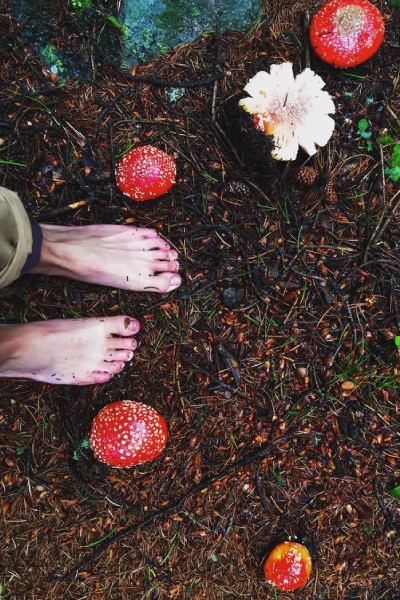 It’s late summer in the mountains, and the forest is full and peaceful. Overhead, a hawk circles, crying to her mate, or perhaps to her offspring, now fledged and hunting on their own. And below my feet, activity hums, carrying the language of trees, plants, and fungi as they, too, call out to their offspring and their forest-mates with the news of the day.
It’s late summer in the mountains, and the forest is full and peaceful. Overhead, a hawk circles, crying to her mate, or perhaps to her offspring, now fledged and hunting on their own. And below my feet, activity hums, carrying the language of trees, plants, and fungi as they, too, call out to their offspring and their forest-mates with the news of the day.
At any given moment, just a few inches below the soil’s surface, thousands of miles of microscopic connections are busy at work exchanging nutrients, water, and information about the state of the forest. These connections are forged between the tiny hairlike root-tips of trees and the microfilaments that make up most of a fungus’s body.These microfilaments fuse with the root tips of trees to form connections known as mycorrhizae (in Latin: myco - fungus, rhiza - root). These mycorrhizal networks, a vast system of support and communication, sustains life across the forest.
Also true to their name, Black Crown Night Herons do the majority of their feeding around dusk and continue through the night. Like most other herons, night herons stalk their prey while wading in shallow waters. While they primarily chose to feed on fish, night herons will also eat earthworms, insects, shellfish, rodents, and reptiles such as lizards and snakes.
 Seems a bit far-fetched to our Darwinian sensibilities, no? However, when you dig into the body of research, the findings make sense. Young trees are too small to receive much sunlight - it could take years for them to be able to produce enough sugar to feed their bodies. ‘Mother trees’ - which may or may not be the biological parent - pump nutrients through the mycorrhizal system to feed the babies until they grow tall enough. On the other edge of the life cycle, stumps have been discovered with living tissues, even though they’ve been without leaves for decades. Younger trees may keep their ‘mothers’ alive for many years after the tree has fallen, supplying nutrients through the network.
Seems a bit far-fetched to our Darwinian sensibilities, no? However, when you dig into the body of research, the findings make sense. Young trees are too small to receive much sunlight - it could take years for them to be able to produce enough sugar to feed their bodies. ‘Mother trees’ - which may or may not be the biological parent - pump nutrients through the mycorrhizal system to feed the babies until they grow tall enough. On the other edge of the life cycle, stumps have been discovered with living tissues, even though they’ve been without leaves for decades. Younger trees may keep their ‘mothers’ alive for many years after the tree has fallen, supplying nutrients through the network.
And what do the fungi get from this relationship? First, a habitat - many species of mushrooms are so closely coevolved with their tree counterpart that they only live among the root networks of one species. Second, fungi are not plants, so they must acquire nutrients by digesting organic matter. Research shows that about 30% of the sugars produced by the trees are maintained in the mycorrhizal networks and used for energy by the fungi. In turn, the fungi metabolize nutrients such as phosphorus and nitrogen and feed them to the trees. It is this exchange of give and take upon which the health of the forest depends.
When we think about conservation, we tend to focus on key species. However, in a forest so exquisitely interconnected, it would be impossible to preserve just one species, or even a handful, for the delicate balance of the forest’s health depends on the actions of each individual. In fractured forests, trees may be present and surviving, but without the intact soil and mycorrhizal network the trees are weakened, cut off from vital sources of nutrients and information. Much like with humans, a strong and supportive community is essential to wellbeing. We depend on one another to support us in times of stress, to pass along vital information, to offer shelter for one another, to care for the young and old. A diverse ecosystem is a resilient ecosystem. Perhaps next time you walk in the forest, you’ll pause for a moment, feeling the strength in the connections beneath your feet. Perhaps, we can all learn a little deeper from our tree kin, strengthen our roots, our systems of support. Perhaps, we and the trees are not so different from one another, after all.
Sources:
https://www.smithsonianmag.com/science-nature/the-whispering-trees-180968084/
https://www.nationalforests.org/blog/underground-mycorrhizal-network
Chapter Four - Plant–Plant Communication Through Common Mycorrhizal Networks
Lindsay Gilkerson is the Backcountry Interpretive Guide at Walking Mountains Science Center. She has a deep and abiding love for all things mysterious, underground, and interconnected. All photos copyright Lindsay Gilkerson 2021









